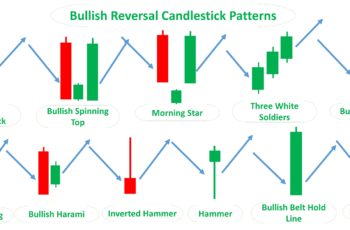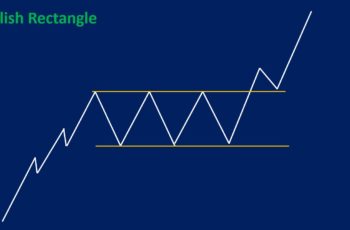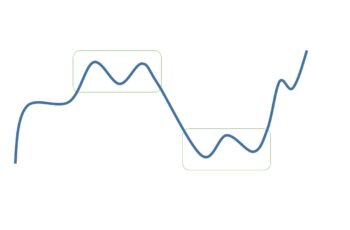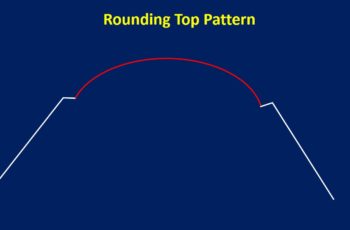A wedge pattern is generally a continuation pattern. However, it can be a reversal formation, explained later in this article.
And Elliott Wave Theory calls it diagonals if it occurs in the first or fifth wave.
A wedge pattern is similar to symmetrical triangles in terms of time that needs to develop and its visual shape. Both formations start with a base, and their support and resistance lines converge and meet at the apex. However, wedge patterns have slanted support and resistance lines.
Wedge patterns are more reliable than triangles. Moreover, their reliability increases when it takes a longer time to develop.
Rising Wedge Pattern
In a rising wedge pattern, the support and resistance lines of the pattern are upward-slanted lines. In other words, both the support and resistance lines of the rising wedge move upward. And it completes when one or two candlesticks close above the resistance line.
A rising wedge pattern is also known as ascending wedge pattern.
This formation is a bearish continuation pattern if it appears in a downtrend. And, as a bearish continuation pattern is one of the most reliable patterns.
However, it can be a bearish reversal pattern if it forms during an extended uptrend.
In a bearish wedge pattern, sell below the support line and put your stop loss above the resistance area. And in a rising wedge that appears at the bottom of the trend, buy above the resistance line and put your stop loss below the support line.
Finally, your take-profit order should be at least twice the size of the risk.
Examples
In early 1991, the weekly chart of the GPJPY chart started descending after the completion of a head and shoulders pattern.
This downtrend made a rising wedge formation which is a bearish continuation structure.
Here is an example of a rising wedge that appeared at the top.
In late September, in the daily chart of Microsoft, an uptrend started with a bullish engulfing pattern. And for the first time, it was challenged by a bearish engulfing which is the beginning of the rising wedge.
At the end of the rising wedge, relatively a large green formed. However, the next day the price opened even below the opening of that day, confirming the reversal of the pattern.
Falling Wedge Pattern
The falling wedge pattern is the mirror image of the rising wedge. It is also known as descending wedge structure.
In this pattern, both the support and resistance lines are rising lines as the formation develops. And it only completes if one large or two medium-sized candles close below the resistance line.
A falling wedge pattern is a bullish continuation pattern when it appears in an uptrend. And it is a reliable bearish consolidation formation.
And it can be a bullish reversal pattern if it forms after an extended downtrend.
So, in a bullish continuation wedge, buy above the resistance line and put your stop loss below the support line of the pattern. And put a take profit order which is at least twice the size of your risk, or adjust your stop loss as new structures appear.
Examples
In late 2005, the weekly chart of JP Morgan Chase completed a falling wedge pattern.
This structure started with a “tweezers candlestick pattern” and ended with a bullish hammer.
After the hammer, six consecutive weeks closed in green. The first three bullish candles combined made a “three white soldiers” candlestick pattern which is also a bullish formation.
Buying above the upper line was a good opportunity because it had many confirmations for the new uptrend. And the stop loss could be below the hammer.
Here is another example from a short-term timeframe. It is a 5-minute chart.
In the following chart, Wallmart Inc made a falling wedge at end of a downtrend.
This pattern was part of the double bottom pattern, which is its top is a bearish harami.
Being itself a bullish pattern and at the same time, the second half of a double bottom was convincing for day traders to go long.
After breaking the upper line the price continued rising, only pausing short period shown as a rectangle pattern.
Buying above the resistance line of the pattern and putting a stop loss below the support trendline turned out to be an amazing trade from a risk-reward ratio perspective.
General Features of Falling and Rising Wedge Patterns
Rising and falling wage patterns do not signal the same. The first is bearish, and the second is a bullish formation.
However, there are features that both share.
And they are:
- The longer that it takes to develop a wedge, the more potent it will be after the breakout.
- In both wedges, the volume decreases as patterns develop and increases when the price breaks the pattern.
- Both wedges predict the future movement against the direction of the pattern. In other words, when a wedge rises it predicts a downtrend, and when it falls, it predicts an uptrend.
Differences Between Wedges and Triangles
Wedges and triangles look similar. And they share some traits.
Generally, both are continuation patterns and sometimes reversals.
But there are not the same.
In wedges, both trendlines are either rising or falling. In a rising wedge, both trendlines rise from left to right, and in the falling wedge fall.
However, in triangles, both trendlines do not have the same direction. In a symmetrical triangle, the support trendline rises from left to right while its resistance trendline falls. In an ascending (rising) triangle, the upper line of the pattern is flat, and the support line is rising. In a falling triangle, the support line of the formation is flat, and its resistance descends from the right to the left.






